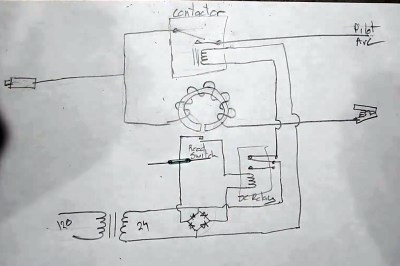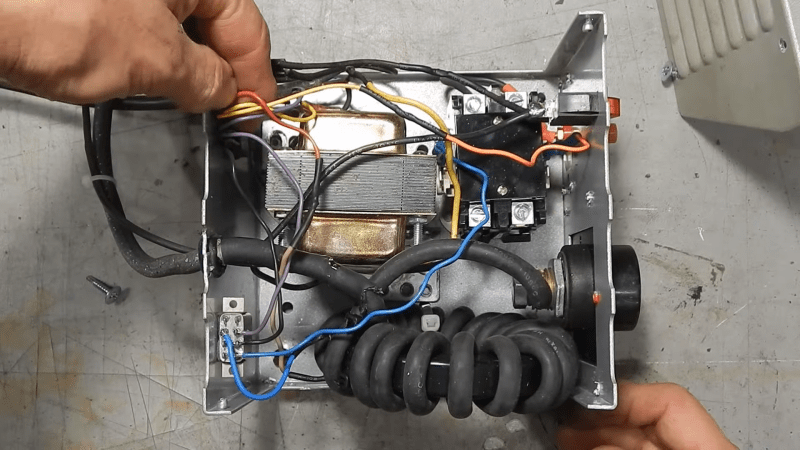Plasma cutters are ridiculously cheap these days, just cruise by the usual online sources or your local Harbor Freight if you’ve got any doubt about that. But “cheap” and “good” don’t always intersect on a Venn diagram, and even when they do, not every plasma cutter is suitable for use on the spanking new CNC table you’re building. But luckily, there’s a mod for that.
As [Jake von Slatt] explains it, there are two kinds of plasma cutters on the market: high-frequency (HF) start and pilot arc start. The basic difference is that HF start cutters, which comprise the majority of cheap cutters on the market, need direct electrical contact with the workpiece to start the cutting action. Pilot arc torches, which are more suitable for CNC cutters, can strike the arc through a separate conductor without the need to contact the workpiece.
 While there are homebrew bodges that claim to turn an HF torch into a pilot arc, [Jake]’s approach is a bit more complicated, and necessarily so. His add-on box intercepts the ground clamp — which is actually the positive conductor for plasma cutting — and switches it through a heavy-duty HVAC contactor. The 24 VDC coil of the contactor is controlled by a homebrew current sensor made from a huge toroid ferrite core wrapped with 20 turns of 6 AWG welding wire.
While there are homebrew bodges that claim to turn an HF torch into a pilot arc, [Jake]’s approach is a bit more complicated, and necessarily so. His add-on box intercepts the ground clamp — which is actually the positive conductor for plasma cutting — and switches it through a heavy-duty HVAC contactor. The 24 VDC coil of the contactor is controlled by a homebrew current sensor made from a huge toroid ferrite core wrapped with 20 turns of 6 AWG welding wire.
Before winding, the core is split in two and epoxied back together with a small magnetic reed switch bridging the gap. A simple 24 VDC power supply runs the whole thing. When the torch starts, the nozzle is connected to ground through the contactor, but as soon as the arc strikes and starts pulling cutting current through that toroid, the magnetic field closes the reed switch, which opens the contactor via a small DC relay. This removes the connection between the nozzle and ground, leaving the plasma to carry all the cutting current.
We’ve featured many, many CNC plasma cutter tables before, but most of these builds have concentrated on the table more than the cutter. It’s a refreshing change to get some insider tips on what kinds of cutters work best, and how to adapt what you’ve got for the job.

















Yes, just changing the torch to a pilot start solves this, the contactor is built into the tip and once air starts flowing it opens the circuit to plasma sustained arc.
Why even comment if you’re not going to bother reading the article or watching the video? The product you’re advertising is exactly what this article is addressing.
I read the article and I also question why the apparently-complicated workaround is worthwhile when you can buy a pilot-arc (or “non-contact”) cutter for $200.
because you may either already own a plasma cutter or you may be able to purchase a better HF model that’s better suited for CNC purposes than a $200 pilot-arc cutter, the workaround really isn’t complicated, and it doesn’t cost anywhere near $200 to do this, even if you value your time highly?
Not to mention a lot of the cheap pilot-arc cutters (and, from what I can tell, all the $40 pilot-arc adapters like the one that that [max] linked) don’t even have a relay that shuts off the pilot arc once the plasma is established. That significantly diminishes the efficiency of your torch and it’s one of the main issues this solution explicitly addresses.
Sensible-Purchase-a-Day dot com
Probably because it IS the same except for being prebuilt, inexpensive, and warranted to work.
I do no get it.
Not quite. It’s a “blow back” torch which is a different thing than a true pilot arc torch. The blow back torch disconnects the pilot arc when air starts to flow, but it needs to be within arc distance of the workpiece to light, otherwise the pilot arc goes out immediately.
Super nice mod. I have also made a cnc plasma cutter for 500euros in total, and had two main problems. the EMI and the ignition not always starting up. for the first i opt for adding shielding coper tape and moving away the electronics and enclosing them in a metal box. For the ignition issue i try to make one line cut pieces, clean the tip and hit the plate to make it touch start. i have also noticed that when it doesn’t ignite the emi is larger. your mod is very nice, and thought that only if i was purchasing an 1500 euros plasma i would be free of these issue. Although i have managed to do most of my workings, do you think your mod would help in both of these issues facing with cheap plasma cutters ? this is what i have built https://www.youtube.com/watch?v=hZDnYn-BYY0
Take a look at this video: https://www.youtube.com/watch?v=idKb246qnAk I had the same RFI problems.
Nice post, thanks
On my todo list when I redo the workshop layout..again…
A very nice and clear explanation of both the problem and his solution. I guess it depends on what your parts bin looks like, but I if it’s for a CNC conversion I’d takle it differently. Using a split core current sensor with a microcontroller to control the main relay would give a lot more flexibility. Like being able to trigger an e-stop if it doesn’t detect a current within a certain timeout period.
That was my first attempt, second was a current shunt with op-amp. Both kept getting blown up by the HF RFI, these cheap torches are REALLY nasty when it comes to RFI and EMI!
Admittedly, I’m not a electronics greybeard, but regarding the current shunt, if it’s some “floating” type with real HV separation between current sensor ports and logic voltage side. I’d guess a HV capacitor or MOV across those current sense inputs would effectively let the nasty volt spikes bypass it.
Also, isn’t the high-frequency start bit essentially like a automotive ignition coil, except for starting the combustion cycle, it’s job is instead to start the plasma arc?
That’s a “blow back” style torch which is not quite the same thing, but it just might work in this application. Definitely good for a handheld torch when working with painted or dirty material for sure, but I’d have to do some testing to see if it would light at pierce height and consistently maintain an arc on a CNC table.